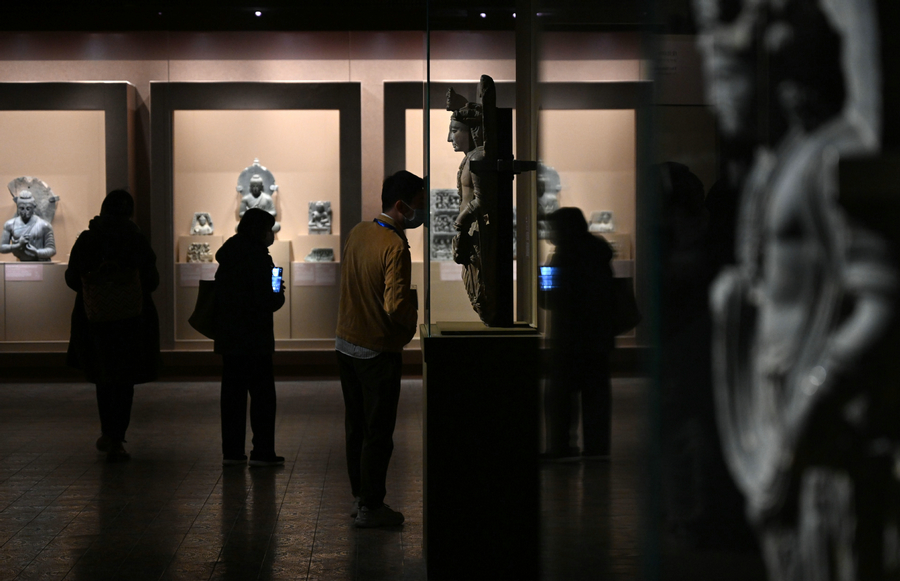The Palace Museum in Beijing has opened an exhibition on Gandhara art titled “Gandhara Heritage along the Silk Road,” which commenced on March 15. [Photo/Xinhua]
The Palace Museum in Beijing has kicked off the largest exhibition of Gandhara art held in China to date. The exhibition, named “Gandhara Heritage along the Silk Road,” is co-organized by China’s Palace Museum and the Department of Archaeology and Museums of Pakistan’s National Heritage and Culture Division. This Pakistan-China joint exhibition features 203 Gandhara artifacts, with 173 of them loaned from the collections of seven Pakistani museums and the remaining 30 from the Palace Museum.
The exhibition’s centerpiece includes life-size and small statues of Siddhartha and Buddha, which depict his birth, early palace life, and the periods after enlightenment. These artifacts are mostly archaeological finds dating back between the 2nd century B.C. and the 10th century A.C. The artifacts also include parts of Buddhist pagodas, gold and silver vessels, and jewelry, highlighting the period’s diversity and glamour.
Gandhara art is a unique blend of ancient Greek, Roman, Persian, and Indian art, with its distinctive style and techniques. It is famous for its intricate and delicate carvings, and the art’s intricate detailing represents the evolution of art from the Greco-Buddhist period to the Hindu-Shahi period.
The exhibition provides visitors with an opportunity to explore the history of the ancient Gandhara civilization that existed in the northwest of the Indian subcontinent, which now lies in Pakistan and Afghanistan. The civilization flourished for over a thousand years, from the 6th century BC to the 5th century AD, and the art and culture of this region left a lasting impression on the Silk Road’s trade and culture.
The exhibition not only showcases the exquisite art and culture of Gandhara but also emphasizes the rich cultural exchanges between China and Pakistan. The Silk Road served as an important channel for cultural and economic exchange between the two countries, and the exhibition represents the shared cultural heritage and friendship between China and Pakistan.
Moreover, the exhibition promotes cultural tourism and encourages people to explore and appreciate the diverse cultures of the Silk Road. The Silk Road, with its rich cultural heritage, has become a popular destination for travelers from all over the world. It provides an opportunity for people to learn about ancient civilizations and the cultural exchanges that shaped the world.
The exhibition is an excellent platform for cultural diplomacy, promoting mutual understanding and respect between nations. Through cultural exchanges, people can learn about different cultures, traditions, and histories, which can help foster international cooperation and understanding.
In conclusion, the “Gandhara Heritage along the Silk Road” exhibition is a significant event that showcases the rich cultural heritage of Gandhara civilization and promotes cultural exchanges between China and Pakistan. It also serves as an excellent platform for cultural diplomacy, promoting mutual understanding and respect between nations.
Gandhara was a historical region situated in present-day northwestern Pakistan and southeastern Afghanistan. The region’s Buddhist visual art form, known as Gandhara art, developed and thrived between the 1st century B.C. and 7th century A.C., significantly influenced by Greco-Roman art.
The Gandhara art style is unique, blending various artistic techniques and styles from Greece, Rome, and India. The art is characterized by intricate detailing and delicate carvings, portraying Buddha and other Buddhist deities in various poses and expressions.
The Palace Museum exhibition in Beijing offers a rare opportunity to explore and appreciate the beauty and significance of Gandhara art. This exhibition features a vast collection of Gandhara artifacts, including life-size statues, gold and silver vessels, and jewelry, highlighting the period’s diversity and glamour.
Those interested in experiencing this exhibition must plan their visit accordingly, as the exhibition runs until June 15. The exhibition is a testament to the lasting impact and legacy of the Gandhara civilization, providing visitors with an enriching and educational experience.
Overall, the Palace Museum’s exhibition on Gandhara art is a unique opportunity to delve into the history and art of one of the world’s most fascinating ancient civilizations.
Read More:
